User:Stephen2nd/Sandbox (b)
| This is not a Wikipedia article: It is an individual user's work-in-progress page, and may be incomplete and/or unreliable. For guidance on developing this draft, see Wikipedia:So you made a userspace draft. Find sources: Google (books · news · scholar · free images · WP refs) · FENS · JSTOR · TWL |

—Preceding unsigned comment added by Stephen2nd (talk • contribs) 00:48, 21 December 2008 (UTC)
The Royal Arms: In the reign of Henry III: English heraldry was regarded as a Science, by being in possession of a system, a classification, and a technical language of its own. It is still the essence of a heraldic language to be concise yet complete, expressive, and abounding in suggestions. The repetition of any important word is scrupulously avoided; and, where it would be required, another form of expression is substituted in its stead. Much meaning is left to be implied and understood. [1] This science of substituted expression of suggestion; was researched in the 19th century by Arthur Charles Fox-Davis, who implied that such expressions were Cyphers.

- CIPHER/CYPHER: A secret or disguised manner of writing, whether by characters arbitrarily invented, or by an arbitrary use of letters or characters in other than their ordinary sense, by making single words stand for sentences or phrases, or by other conventional methods intelligible only to those possessing the key; a cryptograph. Also anything written in cipher, and the key to such a system.
MacDiarmid: ("dia = god; armaid = of arms"):[edit]


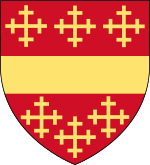
- Armorial bearings of H. T. McDermott: St. Leonards on Sea:[2] (Place on c):
- Shield: Sinister-chief-angle: Arms: Party per pale chevron argent & or, on chevron gules, between in chief three boars’ heads erased at the neck, and in base a cross crosslet azure, three trefoils or slipped of the second: Crest: demi lion rampant or, holding between the paws a boars head erased: Motto: HONOR VIRTUTIS PRAEMIUM: (Honour & virtue its own reward.)[3]
- Mr. Wimberley Heraldry Lecture: (Re: Peerage listing): Doncaster: December 11, 1841:
- "His name, Romanized as it was in the days of Emperor Claudius is found on the pages of Tacitus: Arms: Lord Howden Caradoc, Caratacus. (NB: Howden in Newcastle): Its charge: The Dragon: is one of the most ancient of signs. It is carved on the corners of the Temple of Persepolis. Nothing is of so high account among the Chinese as representations of Dragons. Dragons were the Parthians’ ensigns, from whom the Romans in later times took them; and our Saxon ancestors from the Romans. It was also the device of the ancient British kings, as the lion was of the Norman Dukes. The chariot of the Ceridiven, the Ceres of the Druids, was drawn by dragons, creatures esteemed sacred by that ancient priesthood. Hence the beautiful lines of Gray, when celebrating the triumph of Owen, descended from Cadwallader, a name signifying supreme ruler of battle:
- Dauntless on his native sands
- The dragon- son of MON-a stands:
- In glittering arms and glory drest,
- High he rears his ruby crest.
- The three wheat-sheaves (Earl of Chester) represent abundance and hospitality: Three boars’ heads (McDermott ) the ancient roast beef of old England, is found on many shields of the old families of Anglia, Cambria, and Caledonia. In Scotland, it was sometimes surrounded by little banners, displaying the colours and achievements of the hospitable baron".
- Caradoc Caratacus: (10 AD – 50 AD): (Pre-Iceni; Celtic Brigantes tribe): Reign C1st, to circa 50 AD: Born c. 10 AD ?: Died after c. 50 AD:
- Arms: Party per pale chevron argent, on a chevron gules, between in chief two boars’ heads, and in base one boars’ head azure, three wheat-sheaves or: Motto: CARADOC in chief: TRADITUS NON VICTUS in base: (Betrayed not conquered):
- Crest 1: Caratacus fully armoured & Crowned or, kneeling one knee, oval Shield on left arm, and holding a Sword by blade in right hand, presented handle tipped with Ruby crest:
- Crest 2: Caratacus wearing a Kilt & Crowned or, kneeling one knee, oval Shield on left arm, and holding a Sword by blade in right hand, presented handle tipped with Ruby crest:
- NB: Caratacus: Party per pale chevron: Chevron gules: Three Boars heads: Three Wheat-sheaves or: (NB: Earl of Chester):
- NB: McDermott: Party per pale chevron: Chevron gules: Four Boars heads: Three Trefoils or: (NB: Royal Arms - Royal Badge):
- Rockingham: Patent 12 James I.; illuminated patent: Indented Deed dated 1640ad: Patrimony of MacDermot lineage, including 389 quarters, extending over eight centuries: Last record: per se as “Driven from his ancient patrimony during Cromwellian Wars.”
- Campbell - MacDiarmid: Malcolm of the clan went to Norman France where he married an heiress of the Beauchamp family and adopted that name. A son Archibald accompanied the Conqueror (1066) becoming founder to several English lines. [4]
- 35 Hen. VIII, c. 1 (1544): Succession determined by last Will (1546) of Henry VIII. Settling the Crown of England upon his children, after extinction of her legitimate descendants, the succession "shall wholly remain and come to the next rightful heirs." Edward Seymour, Lord Beauchamp (b.1561), his 3 sons; 3 daughters and brother, were all named as successors to the English Crown and English Throne. The “Beauchamp family” were again named successors after Elizabeth I, and James I.
Mowbray (2nd Plantaganet) Royal Family:[edit]
- Letters Patent granted to Thomas Mowbray and to his heirs (Earl Marshal) Statute 1397. Earl of Chester: Prince of Wales; Heir Apparent; (titles linked): Statute: 1398 Richard II; Royal Arms inc; Edward the Confessor: Three Lions: (NB: England; Duke of Lancaster & Brotherton ): Two Lions Rampant: Royal Crest: ("of the King"): "Two" Ostrich Feathers: Mowbray Duke of Norfolk: (d.1400): Heraldic Achievements originally outside Doges Palace, Venice: NB: Ref: Doge: "Rank of a Sovereign Prince": Ref: “Three” Ostrich Feathers: [5] NB: Ostrich feather silver & pen gold is the King’s: Feather all silver is the Prince of Wales: Feather gold & pen ermine is the Duke of Lancaster’s: [A C F-D]:
- Richard Duke of Normandy’s daughter Harwise, was Geofrey Duke of Brittany’s wife. Their son Eudon, was father of Hawise, wife of Stephen (Comes Britannia), Lord of Richmond. Stephen was father of Maud, the mother of Alice, wife of Roger de Mowbray; son of Robert Mowbray and Maud the daughter of Judith, daughter of the Earl of Chester. NB: Earl of Chester & Caratacus: Arms: three Wheat-sheaves or:
- The son of Edward I. was Thomas Brotherton, who’s daughter Margaret was wife of John Segrave. Their daughter Elizabeth, was wife of John Mowbray, who was son of John Mowbray and Joan, the daughter of Henry Duke of Lancaster, the grandson of Henry III.
- The 1st evidence of a Seymour (Beauchamp) ancestry being usurped occurred in the 1st Reign of King George I. His Prime Minister; Walpole[6](his crest[7]representing the House of Wettin – Queen Victoria) usurped the confiscated; “McDermott – Beauchamp” Arms. (Chevron; six Cross Crosslets, and the English Royal motto: “Dieu et mon Droit”.)
- Usurped again; the (McDermott) "Roscommon Case" (1828); (McDermott & Mowbray) "Earldom of Mar Case" (1875); "Mowbray Segrave Case" ( Mowbray as Earl of March) (1877); (Mowbray) "Earldom of Norfolk Case" (1907); and (100 years after (McDermott) "Roscommon Case" ); again in the (Mowbray McDermott) "Beauchamp Case" (1925).
- Following the "Norfolk Case" (1907); in 1909 Fox –Davis published ‘Complete Guide to Heraldry’: (Page 466). Ref; "Mowbray Segrave Case" (1877) Quote Ref: “Brotherton; and Mowbray Segrave; The Mowbrays, as recognised members of the Royal Family.” [8]
Mowbray McDermott: Records: (C19th - C20th)[edit]
- Successive; patrilineal; eldest (1st born McDermott) sons, James McDermott: (b.1920: m.1951: d.1986): Recorded (Brotherton witness) as 1st born; Mowbray & McDermott heir.
- By James’s (1st) marriage; his first (1st born) son; also James, (b.1948): (d.1965) aged 17. By (2nd) marriage; succeeded by surviving second (1st born) son & heir; Stephen 2nd:
- MacDonnel m. Connor: Son: Connor MacDonnel (Named: McDonald) (b.1891): Drummond m. Campbell: Dau: Campbell Drummond (b.1875): Nicholson m. Drummond: (m.1926):
- Dau: Campbell Nicholson m. Connor McDonald: = Dau: Kathleen MacDonnel Connor Drummond Campbell McDonald (b.1928)
- McDermott m. Mowbray (m.1919) = Son: James McDermott m. Kathleen McDonald (b.1928: m.1951)
- Stephen (1st born son.) (b.29 June 1952): Peter; (b. 4 August 1953): Anthony; (b. 4 August 1953: d.26 December 1988):
- History of James McDermott Snr: b.Newcastle upon Tyne: NB: Birth: (1920): (Under George V and Privy Council): Irish Sovereignty abolished: South Ireland removed from UK:
- Age 16 (1936): George V dead: Edward VIII abdicates: George VI succession: NB: Age 19 (1939): WWII: With Winston Churchills ( Mowbray crest ) Parachute Regiment:
- Demob to 1951: Police Officer ((PC)) Hartlepool. Northumberland: England:
Arms of Newcastle upon Tyne: England:[edit]

- Ref: College of Arms: Exemplification 1954: Newcastle upon Tyne: Arms: Gules '''Three Castles triple towered''' argent: Crest: On a wreath of the colours: A Castle as in the arms & issuant a Demi Lion guardant supporting a flagstaff or flying a forked pennon of the arms of St. George: Motto: FORTITER DEFENDIT TRIUMPANS: Triumphing by brave defence[9]: NB: Ref: Norroy CoA (1575): “The most ancient insignia.”
- Newcastle Arms: Demi Lion: England: St. George: Three Castles triple towered: NB: (Newcastle Museum exhibit): (same crest but) Demi Lion flying Saltire of Scotland:
- The Arms of St. George are: Arms of England: Patron Saint of England: Crusades: NB: Warrant[10]: Royal Arms Badge: Royal Arms of Ireland: Three Castles triple towered:
- Edinburgh Arms: Capital ciy of Scotland: and the Duke of Edinburgh: and Hamburgh Germany: Three Castles triple towered:
The ‘castle’ of Newcastle upon Tyne: (1080ad):[edit]

- Ref: Local Records: Historical Register of Remarkable Events: 1833 (Pg.13-16): 1080AD: The castle of Newcastle (upon Tyne) was built during the reign, and at the command of; William (I) the Conqueror., constructed under the directions of his son Robert Curthose, following his unsuccessful return from an expedition against Malcolm King of Scotland. The castle of Newcastle: was built for considerable strategic importance, to defend the Tyne Bridge, securing at all times, a free pass for English armies returning from Scotland into Northumberland. Rufus, however, was the first to employ arms against it, being opposed and defended by a rebellion headed by Earl Mowbray.
- In 1090AD: Mowbray, Earl of Northumberland re-founded and re-fortified Tynemouth monastery with cannons. In 1093: King Malcolm of Scotland and his son were killed, against the opposition and defences of the Mowbray’s, with his army defeated at their siege of Alnwick Castle, the bodies of King Malcolm and his son being interred in Tynemouth Monastery. In 1095: Mowbray, Earl of Northumberland, having "Raised the Standard" of rebellion against William Rufus, the son and successor of William the Conqueror, the King marched against the castle of Newcastle upon Tyne with a great army, and took it after a short siege, together with several of Mowbray’s partisans. Undeterred, Mowbray converted Tynemouth Monastery into Tynemouth Castle: Thither, William the Conqueror marched with his army against Mowbray in Tynemouth Castle, and after a siege of two months took the Castle by storm.
- Although William captured Mowbray’s brother, and made him his prisoner, Earl Mowbray escaped and took refuge in Bamborough Castle, which William also besieged, but finding it impregnable against Mowbray, erected a castle over against it, fully garrisoned to continue his blockade, whilst William the Conqueror returned south. The besieged Mowbray twice escaped to his castle of Newcastle. Finally pursued, Mowbray eventually took sanctuary in the church of St. Oswin, at Tynemouth, from whence he was dragged out by violence and made prisoner. In 1110, Tynemouth Monastery Castle, which had been so much destroyed in Earl Mowbray’s insurrection, was again re-built. [11]
Kings Statutes at large: (1177 – 1640):[edit]
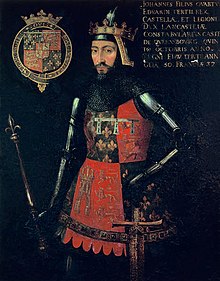
- King John: Statute: Magna Carta: 15 June 1215ad:
- Mowbray: "One of the 25 Barons appointed to enforce the provisions of Magna Carta": (NB: Letters Patent: "and to his heirs "":
- By the Grace of God King of England: Know that before God: To all free men of our Kingdom: We have granted for us and our heirs forever:
- No free man shall be seized or imprisoned, or stripped of his rights, or possessions, or outlawed, or exiled, or deprived of his standing:
- Nor will we proceed with force against him, or send others to do so: To no one will be sell, to no one deny right or justice:
- That men in our Kingdom shall have and keep all these liberties, rights and concessions, well and peaceably in their fullness and entirety:
- For them and their heirs, of us and our heirs, in all things and all places; Forever.
- John I: Statute Letters Patent: (9 John: 1207-08): Letters Patent: "BRAY" ( Mow ):– "CASTLE": - "DERMOTT": - "STEPHEN": [1177]:
- John I: Letters Patent: Leinster: Connaught: Ulster: Meath: Cork: Limerick: Kerry: Ormond:
- Lord of Cork (grant) to Robert Fitz Stephen (1177): Stephen de Longue Espee: (NB: Arms: York Minster ):
- Lord of Kerry (grant) to Earl of Desmond: (Fitz) Gerald [1450] by descent to Mc Dermot: NB: (Ref: Mc & Mac & Fitz = son of ):
- Kingdom of Leinster grant to Richard de Clare (1172) (NB: Mowbray) Earl of Pembroke (Strongbow) m. Eva da. of Dermot McMorough prince of Leinster; King of Ireland. (1177) William Marshal (NB: Mowbray) Earl of Pembroke; Lord of Leinster [grant 1207].
- Lord - Kingdom of Connaught [grant Hen II] to de Courcey. Earl of Ulster. [Grant 1175] to King of Connaught, [King under Henry II]: Hugh, King of Connaught to King John. [grant 1227] to de Burgh Lord of Connaught. s, Walt Earl of Ulster [1243] via Plantagenet; Mortimer; Mowbray [2nd] Plantagenet: Connaught descent to Edward IV:
- Richard II: Statute: (grant): Royal Arms of England: Edward Confessor: Three Lions: Label of three points: NB: Duke of Lancaster: Brotherton:
- Richard II: Statute: (grant) Arms: Two Lions Rampant: Royal Crest: ("of the King"): "Two" and "Three" Ostrich Feathers:
- Richard II: Letters Patent [1397] Mowbray (2nd) Plantagenet [1399] descent to Edward IV.
- Richard II: Letters Patent: Mowbray Earl Marshal: Decree 1398: Earl of Chester: Prince of Wales: Heir apparent: Titles inseperatably linked:
- Henry VI: Letters Patent: Palatine Honours: Barony by Writ: Irish Baronage composed exclusively of male heirs of Henry VII: recognised Peers [1489]: Peers enobled by Letters Patent: Lord-Earl Palatine (cinctus gladio) Ulster: Ulster Earl de Courcey [1181] de Lacy [1205] (NB: Mowbray): de Burgh [1264] Plantagenet [1354-1425] Margaret Brotherton (Wife; John Segrave) Duchess of Norfolk: Lady of Catherlogh - Honour of Carlow: Bigood = (NB: + D' Aubigny + Moubray = Royal Scots lion & tressure): [1245] Plantagenet [1306] Segrave [1397] Mowbray [1399]
- James I : Letters Patent: Writ of Summons: *(his own) Hereditary Scots Peerages: Kingdom of Scots: Angus; Buchan; Caithness; Carrick (NB: McDermott and Mowbray ); Fife; Galloway; Mar (NB: McDermott and Mowbray ); March (NB: Mowbray ); (Rockingham Letters Patent); "Illuminated patent by indented Deed dated 1640ad, family patrimony of MacDermot lineage including 389 quarters extending over eight centuries" (NB: Circa 840ad to 1640ad).
- James II: Letters Patent: Writ of Summons: *(his own) Hereditary Irish Peerages: Ulster [1205] Carrick (NB: McDermott and Mowbray ) [1315] Kildare (NB: McDermott) [1316] Louth [1319] Ormond [1328] Desmond (NB: McDermott ) [1329] Waterford [1446] : NB: King James II; ""expressed words"" his Irish predecessors:
- King James ( I ) version of the Holy Bible:
- “Great and manifold were the blessings, most dread Sovereign, which Almighty God, the father of all mercies, bestowed upon us the people of England, when first he sent your Majesties Royal Person to rule and reign over us... We may rest secure and supported within the truth and innocency of a good conscience, which will ever give countenance to honest and Christian endeavours against bitter censures and uncharitable imputations.
- George VI: "A Message from his Majesty the King": To all serving in my Forces by sea or land, or in the air, and indeed, to all my people engaged in the defence of the Realm, I commend the reading of this book. For centuries the Bible has been a wholesome and strengthening influence in our national life, and it behoves us in these momentous days to turn with renewed faith to this Divine source of comfort and inspiration.” [12]
Royal Standards: College of Heralds (MS. 1590):[edit]

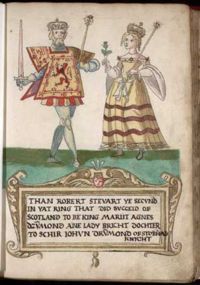
- Henry V: Arms: The Cross of St. George: Argent and azure: A Swan with wings displayed argent, beaked gules, membered sable, ducally gorged and chained or, between three "STUMPS OF TREES ", one in dexter chief, and two in base of the last:
- DIEU ET MON: Two stumps of trees in pale or:
- DROYT: Five stumps of trees, three in chief, and two in base:
- Henry VII: Arms (1): The Cross of St. George: Argent and vert: A Greyhound courant argent (''McDermott: Crest), collared gules: Whole being seme of Tudor roses, Portcullises, and Fleurs-de-lys or: Also Henry VII Arms (2): A Dragon gules (NB: The Red Dragon of Cadwallader ), "between two roses" of the last in chief, and three in base, argent:
- DIEU ET MON: A rose- gules in chief, rose- argent in base:
- DROYT: In chief three roses gules, in base two argent:

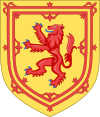
- Earl of Mar (1875): Chiefs Standard: Arms: The Scottish Saltire of Scotland: DEMI LION in chief, on a Cap of Maintenance ermine in base:
- JE PENSE: A hand from a Cap of Maintenance ermine, couped at the wrist, holding a dagger erect, it’s blade within an Earls coronet in chief: (NB: BADGE: it’s blade within the word PENSE on - two Ostrich feather - Mar Garter): (NB: PENSE: See Motto of the Order of the Garter ):
- PLUS: Demi Lion in chief on Cap of Maintenance ermine in base:
- Swinton of the Ilk[13]: Arms: Three Boars (NB: McDermott ): Crest: Boar and Tree: Motto: "Je Pense": Clansman Badge: JE PENSE PLUS on encircled Garter Belt: Two and three feathers: Swinton of the Ilk Seal: Reversed [ N ]: NB: SEE: Kings Manor. York: Sir John de Swinton: Genealogical chart [14] Donald Earl of Mar: (Checky Arms): King Robert (I) and Queen Isabella of Mar: King Robert (III) and Queen Annabela Drummond: King Robert the Bruce: Houses of Stewart and Stuart: Moubray:(D' Aubigny+Bigood)=Royal lion Scotland & tressure) Douglas: Seton:
- Mowbray Arms: Demi lion augmentation: Royal Tressure of Scotland: upon arms of the Earl of Mar: NB: Checky Arms (3rd quarter) (NB: Beauchamp Seal ): Donald Earl of Mar: Stewart Earl of Galloway: Stewart de Rothesay: Duke of Rothesay:
Cipher Records: Heraldic (family) Trees:[edit]
- In 1897, Joseph Grego of the Kernoozer's Club; “Armour-club par excellence in the world;” published numerous Cipher references to dignitaries and royalty; "Duke of Wellington: Mr. Coffin: Mr. Graves: NB: 325g Carlyle Relic: James FitzJames Stephen KCSI 1st bt: Prince of Wales":[15]
- Published two decades before my fathers birth; James: (Fitz) James: and Stephen, were the first names, of the three successive Mowbray McDermott; 1st born sons. Moreover, the “date of creation” of this (“Stephen”. KCSI (Cipher) 1st bart) was on 29 June 1852. Following James (Snr & Jnr); Stephen Mowbray McDermott was born on 29 June 1952. Parallels were also found in (McDermott) Mowbray; birth and marriage records, such as Prince Albert’s descendant's being named the same as (earlier) Mowbray birth names, also including the same parallel that Lord Stourton: (NB: Mowbray Segrave Case: 1877: Created Lord Mowbray and Segrave) also named his 1st born son Stephen in 1953.
- 1852: Prince Albert of Saxe-Coburg, appointed himself to several offices left vacant by the death of Duke of Wellington, including mastership of Trinity House[16]: (NB: Newcastle upon Tyne:[17] ): Arms: (St. George): Crest: demi-lion rampant: (NB: Demi Lion Crest: McDermott: [18]: Wellington: [19]: Newcastle upon Tyne:[20]): Prince Albert also determined the Wellington Augmentation:[21]: British Union Jack flag on shield, as a Royal Badge imperially crowned: As represented on: “The Royal Arms of Great Britain, as determined by the Warrant, in the reign of Queen Victoria.” [22]: "These badges which appear on the Sovereign’s warrant, are never assigned to any other member of the Royal Family, of whom the Prince of Wales is the only one who rejoices in the possession of officially assigned badges": NB: York Minster: Royal Harp Badge: On McDermott-Haig Cadet [23]:) Arms.
- 29th June 1991: York Minster: Chapter Clerk: Signed statements: Quote: "The Duke of Wellingtons crest is a (Demi) Lion Rampant holding the flag of St. George". Also: "On the Duke of Wellingtons memorial brass in All Saints Chapel, the name J McDERMOTT appears." The All Saints Chapel, (Duke of Wellingtons Regimental Chapel), is above the Rockingham (McDermott) family vault, which is directly opposite (due north) the St. Stephen Chapel (Cipher-Key-Gate), being above the Mowbray family vault: The Mowbray and McDermott family vaults each being either side of the York Minster Main Altar: The Stained-Glass window in All Saints Chapel, depict Mowbray arms of the Howard Augmentation:
- The 1919 Mowbray McDermott marriage certificate also contains numerous, personal and heraldic, references to SAW'S and TREE'S:
- McDermott Marriage: Registrar Hamilton: Crest: Tree with Saw through it: McDermott and Drummond were (Wood cutters): Mowbray (Crest: Saw in hand): NB: Earl of Mar Crest: Tree & Boar: Also: Henry V: Arms: DIEU ET MON: Two stumps of Trees: DROYT: Five stumps of Trees:
York Minster: The Red Dragon of Cadwallader:[edit]
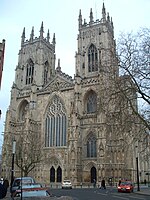

- Following the “Aylesford Case” (1885); George Cokayne published Volume 1. of the 'Complete Peerage' books: (A – Bo) (1887); the "Earldom of Mar Case" (1875); and "Mowbray Segrave Case" (1877) were published by Cokayne; Volume 5. (L - M) 1893.
- (1977): Governing Board: International Acadamy of Heraldry & College of Arms, Quote: “The princes of Sax Coburg-Gotha were excluded from the British royal family in 1893[24],” "The reigning royal family in Great Britain goes back to Prince Albert of Saxe-Coburg, husband of Queen Victoria. In 1917 the name of Saxe-Coburg was changed to Windsor''.[25]." NB: “Elizabeth (II) Sax Coburg-Gotha” succeeded George VI (1952), on advice of her Privy Council (Philip; 1951) changed her name to Windsor, pre-coronation in (1953).
- Royal family to McDermott: 12 April 1954: "McDermott children - An organisation (Ref: Privy Council) will look into your case and see whether there is anything that can be done." (Re: BBM.): NB: James Mowbray McDermott Jnr; Born 1st August 1948. (Re: BBM: died in Australia on 28th July 1965, aged 17.)
- "Daily Mirror" 28 September 1991. Lord Chamberlain (Quote: 1969) "Bury the King (?) and prepare Charles as Prince of Wales."
- York: 11 December 1969: Mowbray# & McDermott#: Family vaults# in York Minster: Prince of Wales Official Visit. "The Minster was very glad to welcome the prince of wales (NB: and his High Steward, Lord Halifax) on Friday 11 December, in the course of his official visit. He spent over an hour in the Minster. At his own request his visit was primarily to see the archaelogical excavations#, in all of this he showed great interest."
- "Plate III: Royal Commission: Archaelogical excavations#; Photography down there was not easy. But time was against us, not only were the Dean and Chapter quite naturally anxious for us to vacate the vault#, but with the change in equilibrium caused by the chamber being newly reopened, the coffins had begun to leak. Working fast together, the RCHM photographer, John Bassham and I completed the photographs. Even so, before we had finished, our feet were paddling in the unpleasentness leaking from the coffins."
- 13 June 1991: Narroy and Ulster King of Arms: College of Arms: “Stephen McDermott's Red Dragon of Cadwallader has a label of three points." NB: 15 June 1991: Trooping the Colour: Notified; CoA: Inner & Middle Temple; NSY; Displayed my Red Dragon banner, fitted with its corresponding Royal Arms standard (“Flag of the Prince” – R-W-B & Royal Arms) before all assembled public and military witnesses, to Queen Elizabeth II, her family and dignitaries, at Trooping the Colour parade in London. NB: Being one year prior, to the 777th anniversary of (Mowbray) signing Magna Carta (15 June 1215): NB: I was born two weeks after 737th Magna Carta: 1952 Year of the Dragon:
- 29th June 1991: York Minster: Chapter Clerk: Signed statement: Quote:
- "Mr Stephen McDermot displayed the Royal Arms of the Red Dragon of Cadwallader in St. George Chapel, York Minster, on Saturday 29 June 1991."
Mowbray Segrave Case: House of Lords 1877:[edit]
- Quote: “The findings of any Committee for Privileges or the decision of the House itself are not necessarily binding on their successors in other cases ("there are good precedents for this contention".) But it may be still open to the Crown to ""try it on again"" in precisely the same form, that a Committee for Privileges and a House with a different personnel, and in the altered circumstances of the status and powers of the Chamber, would come to a different decision.”
- Affidavit of Throne Succession: (prior claim): 1994:
- Affidavit: Signed 11 May 1994: Commonwealth Premier KCMG: Stephen Mowbray McDermott KC Esq:
ISBN: References:[edit]
- ^ English Heraldry: Boutell (1904)
- ^ Art of Heraldry; Encyclopedia of Armory. A.C. Fox-Davis. (1908) ISBN: 0906223342.
- ^ Art of Heraldry; Encyclopedia of Armory. A.C. Fox-Davis. (1908) ISBN: 0906223342.
- ^ Campbell. p55: Collins Guide: Scots Kith and King: A Guide to the Clans and Surnames of Scotland. ISBN: 0004356659.
- ^ Archaeologia: (1842): Vol. XXIX: App. 387:
- ^ The General Armory of England, Scotland, Ireland and Wales.
- ^ Heraldry. Sources, Symbols and Meaning. Neubecker (1977). ISBN: 0316641413. pg 164.
- ^ A C Fox-Davis: (1909): A Complete Guide to Heraldry:
- ^ City and County of Newcastle upon Tyne: College of Arms: (Exemplification 1954):
- ^ Art of Heraldry; Encyclopedia of Armory. A.C. Fox-Davis. (1908) ISBN: 0906223342.
- ^ Sykes: Local Records: Historical Register of Remarkable Events: (Pg.13-16): 1833:
- ^ George VI: 15 September 1936: Holy Bible: Active Service Edition.
- ^ Art of Heraldry; Encyclopedia of Armory. A.C. Fox-Davis. (1908) ISBN: 0906223342.
- ^ G.E. Cokayne: The Complete Peerage: 2nd Edition:
- ^ Victoria Era Exhibition (catalogue. pg 45: 325a to 325h: 1897):
- ^ Art of Heraldry; Encyclopedia of Armory. A.C. Fox-Davis. (1908) ISBN: 0906223342.
- ^ Art of Heraldry; Encyclopedia of Armory. A.C. Fox-Davis. (1908) ISBN: 0906223342.
- ^ Art of Heraldry; Encyclopedia of Armory. A.C. Fox-Davis. (1908) ISBN: 906223342.
- ^ Art of Heraldry; Encyclopedia of Armory. A.C. Fox-Davis. (1908) ISBN: 0906223342.
- ^ City and County of Newcastle upon Tyne: College of Arms: (Exemplification 1954):
- ^ Art of Heraldry; Encyclopedia of Armory. A.C. Fox-Davis. (1908) ISBN: 0906223342.
- ^ Art of Heraldry; Encyclopedia of Armory. A.C. Fox-Davis. (1908) ISBN: 0906223342.
- ^ Art of Heraldry; Encyclopedia of Armory. A.C. Fox-Davis. (1908) ISBN: 0906223342.
- ^ Heraldry. Sources, Symbols and Meaning. Neubecker (1977). ISBN: 0316641413. pg 164.
- ^ Heraldry. Sources, Symbols and Meaning. Neubecker (1977). ISBN: 0316641413. pg 164.

